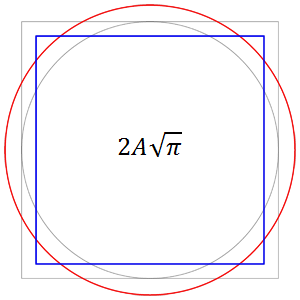π is not transcendental? Say what?
 Which step did I commit a fallacy?
Which step did I commit a fallacy?
Step 1 :
With my calculator, I get sin ( 2 0 1 7 5 2 ) = − 1 = sin ( − 2 π )
Step 2 :
Because the f ( x ) = sin ( x ) has period 2 π ,
2 0 1 7 5 2 = − 2 π + 2 π n , for a certain integer n
Step 3 :
Rearrange the equation and set π as the subject
π = 4 n − 1 2 0 1 7 ⋅ 2 6 / 5
This means π is not a transcendental number but an algebraic number.
This section requires Javascript.
You are seeing this because something didn't load right. We suggest you, (a) try
refreshing the page, (b) enabling javascript if it is disabled on your browser and,
finally, (c)
loading the
non-javascript version of this page
. We're sorry about the hassle.
8 solutions
If you try to find sin 2 0 1 7 5 2 with [...] WolframAlpha, you will see that it is equal to − 1
I'd say otherwise. But otherwise correct.
Log in to reply
Log in to reply
...click "More digits", of course...
Log in to reply
@Ivan Koswara – Click radian mode, and I see you got -1.000... but I typed in 1/5 as the power, and I got a lot of digits... weird...
It is also nice to know that according to wolfram the number sin ( 2 0 1 7 × 2 1 / 5 ) is also a transcendental number.
True that, but it must also consider that the calculator do not count every decimal point on π, therefore the radian that was put in is concidentally the same with π. I have checked with a calculator that the number is actually the same with π up to the 11 decimal points. The calculator might only count up to 11 or up to 10, which makes the calculator mistakes it as a π.
That's a tricky error... I would have never realized.
Log in to reply
You should have been dubious when sin x was equal to − 1 with an argument that was not some variation of π .
because calculators also do approimation after a certain place after point
sin(-pi/2) = zero, not -pi/2, I believe that is also wrong.
SIN(THETA) = SIN(PHI) DOES IT IMPLY THAT THETA EQUALS PHI
sin ( 2 0 1 7 5 2 ) only approximates − 1 , not exactly equal to − 1 . Indeed, a trip to WolframAlpha tells that it differs on the 17th digit. Most calculators, even floating point types on programming languages (64-bit floating data types), can only carry about 16 decimal digits, so the result is rounded down to − 1 .
In any case, "with my calculator" is not a rigorous step, so Step 1 is incorrect.
रिघत यौ अरे
Logically Step 1 is false, otherwise it will be taught in schools and Brilliantant Pi Han Goh would have received his Nobel prize for this amazing discovery.
BEST ANSWER RIGHT HERE! +1
LOL...nice answer @Chew-Seong Cheong !!!
sin of the measure given = 0.3919424427...... which contradicts given info...so step 1
Your calculator is configured to degrees. We are talking about radians here.
Ok...thnks dude
Assuming you've read the other solutions, we can now come to a general consensus.
Transcendental functions can only produce algebraic results when taking transcendental arguments.
*A transcendental number is basically a number that can't be made using rational numbers and basic algebra. Logarithms, exponentials with e (2.718...), and trigonometric functions aren't basic algebra. They are transcendental functions.
S t e p 1 is wrong as it is NOT an exact equation, it is only an approximation.
Trigonometric function is a transcedental function. 2017*2^(1.5) is an algebraic number. Therefore the statement in step 1 is wrong.
Step 1 : Tried with a calculator. \( 2017\sqrt [ 5 ]{ 2 }\) is not equal to \(\sin ^{ -1 }{ (1) } ={ 90 }^{ \circ }=0.5\Pi \) . Condition were set as to what is the fallacy... so choosing only one answer (since it should be picked only once) leads to.... you know.
If you try to find sin 2 0 1 7 5 2 with a calculator or WolframAlpha, you will see that it is equal to − 1 . However, if it is in fact equal to − 1 , then it is equal to 2 k π + 2 3 π . This value is always divisible by 2 π , so you would expect 2 π 2 0 1 7 5 2 to be an integer. However, you will find that is equal to 1 4 7 5 . 0 0 0 0 0 0 0 0 4 1 6 8 . . . which is not an integer. Therefore, 2 0 1 7 5 2 = 2 π k for integer k . sin 2 0 1 7 5 2 is very very close to − 1 , but it is not equal to − 1 exactly. The mistake is in Step 1